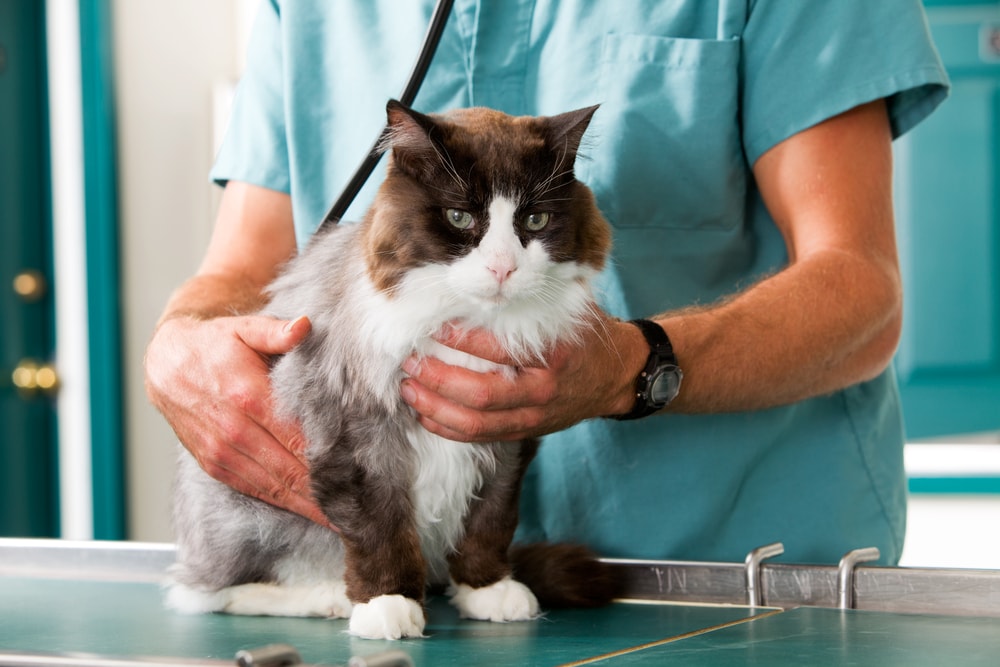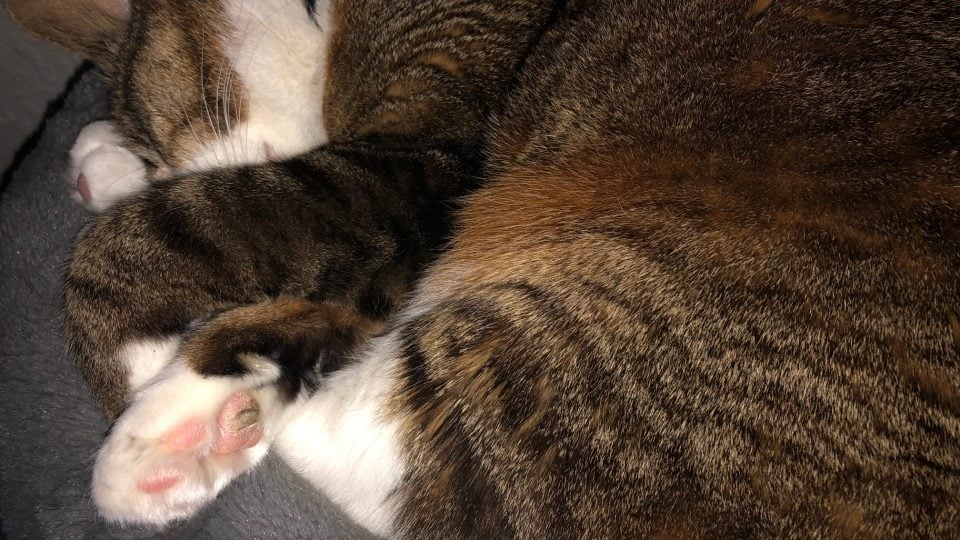sarcoma in cats foot
The tumor types behave similarly and are therefore treated the same. Osteosarcoma is very painful.

Signs Of Cancer In Cats How To Tell If Your Cat Has Cancer Daily Paws
Over time it will grow the tissue within the mass will die necrotize and the tumor will ulcerate.

. These rare types of fibrosarcomas typically grow very fast. If your cat has an osteosarcoma of the limb appendicular osteosarcoma lameness or a distinct swelling may be noted. Your cat may be.
It is usually chosen to treat tumors with a higher likelihood of metastasis but can also be used as an effective method to target cancer cells in cats with vaccine-associated sarcomas. Nerve sheath tumor previously called neurofibrosarcoma schwannoma hemangiopericytoma Rhabdomyosarcoma. Anatomically these tumors arise from mesenchymal cells the precursors of bone cartilage and other connective tissues.
Feline sarcoma virus FeSV is a rare hybrid virus that causes an extremely fast growing type of fibrosarcoma. Skin tumors are some of the most commonly identified tumors in cats primarily because the skin is particularly susceptible. According to research this virus only occurs in 2 percent of cats and they are typically young ones that have also contracted Feline Leukemia Virus FeLV.
Cats may lick or chew the area and cause self-trauma. These include soft tissue sarcoma fibrosarcoma and squamous cell carcinoma. Soft tissue sarcomas or STSs are a group of cancers that arise from skin and subcutaneous tissues.
They tend to have similar histologic appearance and biological behavior and can be either benign or malignant. Most soft tissue sarcomas are solitary tumors in middle to older aged pets and tend to be over-represented in large breed dogs. These tumors are the result of abnormal production of these cell types in an uncontrolled manner.
Soft-tissue sarcomas comprise approximately 15. Although SCC most commonly occurs on the facial face area in cats it can occur anywhere including the toes. Most seem to be caused by a complex mix of risk factors some environmental and some genetic or hereditary.
These tumors do not seem to have a genetic basis. While this form of cancer can affect any breed of cat it remains a rare type of foot cancer in cats. Fibrosarcomas are the second most common oral tumor in cats.
Soft tissue sarcomas are a broad category of tumors including those that arise from the connective muscle or nervous tissues in dogs or cats. Limping or not wanting to move around. Sarcomas affecting various body tissues have always been seen in cats but since the early 1990s the occurrence of sarcomas at sites commonly used for vaccination such as the shoulder lumbar region lower back flank side of body and upper hind leg led researchers to see if there was a direct association with vaccination.
An injection-site sarcoma is a tumor of the connective tissues in the cat. What are the signs of osteosarcoma. Rhabdomyosarcomas are tumors that are often found in the larynx voice box the tongue and in the heart.
Risk of malignant tumor metastasis. The term soft-tissue sarcoma encompasses a broad category of tumors that show up in a cats connective muscle or nervous tissues. They vary in size from less than 04 inches 1 centimeter to more than 4 inches 10 centimeters in diameter.
Very few tumors and cancers have a single known cause. Swollen toes or feet. This is a malignant easily metastasizing spreading.
Another treatment option is chemotherapy. A rare type of cancer called feline lung-digit syndrome may also cause tumors to appear on the toes or feet. Symptoms of this condition include.
Connective muscle and nervous tissues are present throughout the entire body. Peripheral nerve sheath tumor. Chemotherapy consists of four to six treatments given at three-week intervals.
Therefore these tumors can develop over the chest. Common STSs in cats and dogs are. These tissues represent 15 of all skin tumors and 7 of all subcutaneous tumors in cats and dogs.
Melanocytic tumors are benign or cancerous growths arising from melanocytes pigment-producing skin cells and melanoblasts melanin-producing cells that develop or mature into melanocytes. Soft tissue sarcomas can arise in any part of the pets body but skin and subcutaneous tumors are the most commonly observed. Other tumor types have been described osteosarcoma chondrosarcoma malignant fibrous histiocytoma.
These tumors generally appear as firm solitary often hairless or ulcerated lumps. These tumors are very invasive locally meaning they invade the adjacent tissues which can make management difficult. The reason why a particular cat may develop this or any cancer is not straightforward.
SCC of the toes represent about 25 of all digital tumors in cats. Several types of skin cancer can affect the toes as well. These tumors arise from the fibrous and connective tissues of the oral cavity.
Feline sarcoma virus. What are soft tissue sarcomas. What causes this cancer.
The most common cell type affected is the fibroblast giving the tumor the name fibrosarcoma. The lumps may stick out like stalks from the skin surface. However cat ages 8 to 14 seem to have a predilection.
Soft tissue sarcoma refer to a broad group of tumors that originate from connective tissues. Tumors of the toes especially the nail bed can cause swelling pain loss of the nail and lameness. The SCC does not retain its appearance as a solid mass.
Melanocytic Tumors of the Skin and Digits in Cats. Rhabdomyosarcoma in Cats. In cats these tumors are often dark in color.
Lesions with or without pigment Enlarged lymph nodes Difficulty breathing Lung cancer Limping if spread to limbs. They arise from striated muscles banded - not smooth muscles of the skeletal and cardiac musculature in adults and from embryonic stem cells in juveniles.

Nasal Squamous Cell Carcinoma In A Cat Treated With One Session Of Download Scientific Diagram
How To Help Your Cat Fight Cancer Naturally Homeoanimal Com

Mast Cell Tumors In Your Cats Kittens Venetian Pet Hospital

Nasal Squamous Cell Carcinoma In A Cat Treated With One Session Of Download Scientific Diagram

Foot Or Toe Cancer In Cats Symptoms Causes Diagnosis Treatment Recovery Management Cost

Ways To Treat Hemangiosarcoma In Cats Petcarerx

4 Types Of Cat Cancer And Their Common Symptoms Rau Animal Hospital

Feline Fibrosarcoma Bluepearl Pet Hospital

Pin By 𝐒𝐨𝐟𝐢𝐚 𝐑𝐚𝐦𝐨𝐬 On Aesthetics N Vibes N Gifs Animals Cats Vibes

Learn About Soft Tissue Sarcomas In Cats Petcure Oncology

Does Your Pet Have Cancer 10 Signs Of Cancer In Cats And Dogs Southern Crossing Animal Hospital

Learn About Osteosarcoma Bone Cancer In Cats Petcure Oncology

Coping With Cat Cancer Symptoms And Advice Blue Cross

Pin On Animals For The Love Of

Mast Cell Tumors In Cats Symptoms Causes Treatments Cattime Cats Cat Symptoms Cat Facts


